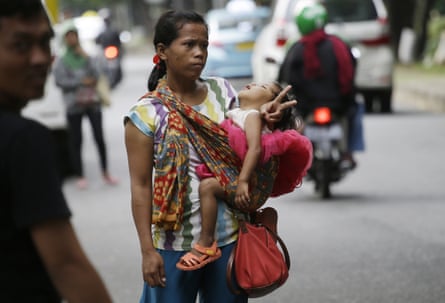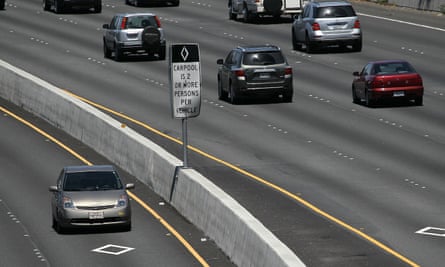Driving in Jakarta at rush hour is something of a nightmare. The city’s 9.6 million population swells each work day with an additional 3.5 million people travelling in from outskirts, mostly by car or bus. Driving 25 miles from the suburb Bogor takes on average two hours, or even three. By some measures, Jakarta has the worst traffic in the world. Others only put it in the top 25; regardless, Jakarta drivers are guaranteed to spend significant portions of their lives stuck in gridlock.
To help alleviate the problem, the city implemented one of the world’s most stringent car-pooling policies. First launched in 2003, the “three-in-one” high occupancy vehicle (HOV) lane rule required private vehicles to carry three people to drive on the main roads in Jakarta’s central business district, from 7-10am and 4.30-7pm.
“Even with the policy in place the traffic was bad, so a lot of people felt like it wasn’t doing anything,” says Rema N Hanna, a Harvard professor of south-east Asian studies. There was also controversy surrounding the “jockeys” who would stand just outside the enforcement area and offer to join a single-occupancy vehicle for a fee so the driver could enter the three-in-one zone.

Many believed the policy was ineffective and felt that opening the restricted road to all would help traffic flow better, but a new study published in the journal Science found the opposite to be true. Hanna and MIT researchers Gabriel Kreindler and Benjamin A Olken discovered traffic congestion worsened after Jakarta lawmakers abruptly eliminated the HOV policy in April 2016.
To collect data on traffic congestion, they used the Google Maps API to measure real-time driving speeds on two restricted roads and several unrestricted routes. They grabbed traffic speed data every 10 minutes for 24 hours a day, using the data Google captures from real-time reports of traffic from Android smartphone users. (This is what Google Maps uses to determine green, yellow, and red traffic conditions and provide estimated drive times.)
The researchers collected their baseline data before and after the car-pooling policy was removed, using traffic delay – the minutes per kilometre someone must wait – as their metric.
Average delays – including on non-restricted roads – rose from 2.1 to 3.1 min/km in the morning peak and from 2.8 to 5.3 min/km in the evening peak. (For comparison, a study found Los Angeles’ delay to be just 0.7 min/km.) Hanna says this indicates that the newly unrestricted main roads were unable to accommodate the increase in vehicles from people no longer car-pooling. The researchers tracked the traffic data through the summer and found it held fairly steady.

“Basically, it meant that even though people said everyone tried to get around the rules, that was not happening at a large enough level to outweigh the benefits of the policy,” Hanna says. “The policy was surprisingly effective in encouraging people to car-pool and get fewer cars on the road. It has a huge implication for traffic and also pollution and lots of other things.”
Co-author Kreindler cautions that their findings in Jakarta may not be applicable to every city with HOV lanes. For example, Jakarta’s policy restricted entire roads, not just one or two lanes of a highway as in other cities.
First implemented outside Washington DC in the 1970s, HOV lanes are now found in at least 27 US cities, and are less common elsewhere. Amsterdam was the first European city to experiment with HOV lanes, opening its short-lived experiment in 1993; Spain followed with an HOV lane in 1995. Stockholm, Sweden, Oslo and Trondheim in Norway, and Linz, Austria added lanes in the intervening years. In the UK, Leeds, Bristol, Birmingham and Bradford all have HOV lanes.
More recently, cities have experimented with other car-pooling policies. Some US cities have implemented high-occupancy toll lanes, which charge a fee for single-occupancy vehicles. Washington DC, Birmingham, Alabama, and Atlanta, Georgia will pay commuters a small daily cash incentive for several months if they car-pool to get them in the habit of doing so. Portland, Oregon offers car-poolers preferential parking. And Los Angeles created an app to connect drivers with passengers.
Jakarta’s bygone car-pool policy may not be a perfect analogy for other cities, but Hanna still thinks there are lessons to take from their study. “What I hope we did was give some evidence that these policies, even though there’s a lot of controversy to begin about them, they’re not entirely crazy.”
Follow Guardian Cities on Twitter and Facebook to join the discussion, and explore our archive here

Comments (…)
Sign in or create your Guardian account to join the discussion